Opinion: If we want to keep our architectural heritage, why do we tax those who repair it?
It beggars belief that the state lists buildings in order to protect them — and then doesn’t contribute to their upkeep, says Country Life columnist Agromenes.


Britain is one of the meanest of advanced countries when it comes to support for ancient buildings, particularly churches. This year, as France was celebrating the state’s huge contribution to the rebuilding of Notre Dame, our Government was announcing a cut in help given to listed churches to pay for repairs. It beggars belief that the state lists buildings in order to protect them and then doesn’t contribute one farthing to their upkeep.
Indeed, it’s worse than that. In Britain, the Government taxes repairs. The money raised to save church buildings, entirely by voluntary contributions, is subject to 20% VAT. The Government then has the effrontery to claim as a ‘grant’ the fact that it has agreed that some of that tax will not be levied. This year, even worse, the misnamed Listed Places of Worship Grants Scheme has been cut and capped so that it does not apply to some of the most important restorations where tax will have to be paid out of voluntary contributions.
It is a disgraceful ramp invented by the Treasury and applied under successive governments. It tots up all the VAT that hasn’t been levied because of the scheme; it then calls that a ‘grant’ and takes the total out of the money given to the Department for Culture, Media and Sport. That reduces the resources available for heritage more generally and so, for every church that benefits, some other historic building suffers. There is no need for it. Agromenes is no supporter of Brexit, but, having left the EU, we have total control over VAT and we make the rules. What, then, are we doing asking people to raise money for repairs (which other European countries would pay for from taxation) and then fining them 20% for the privilege?
Earlier this year, with mind-blowing audacity, the Government announced its cut-priced, short-term scheme by calling it a ‘£23 million package to support restoration’. Actually, it was a decision not to purloin £23 million from the money raised by volunteers to keep the roofs on listed churches. Now, when we’re half way through the year, it appears likely that, in 2026, it will cut the whole scheme and take £23 million more out of the charitable fundraising as a tax. That is why Agromenes is raising it now.
'In a sane society, taxpayers would contribute directly to this, but even if we are philistine enough to leave it all to charity to do, we should at least stop taxing the freely given contributions of those who care'
We who care about Britain’s architectural heritage in general, and our village churches in particular, whether church-goers or not, must demand that the Government removes VAT on repairs and restoration of listed church buildings. If that means that others pay more VAT, so be it. It would be a small price to pay for the voluntary conservation of our built heritage. In a sane society, taxpayers would contribute directly to this, but even if we are philistine enough to leave it all to charity to do, we should at least stop taxing the freely given contributions of those who care. Let’s encourage good works, not tax them.
In our tiny village, the church is the one central place we have and — Anglicans, Catholics and non-believers alike — we keep it in repair. It is a never-ending struggle of fêtes, raffles, gift days and individual generosity. It is paid for by people who want their children and grandchildren to have what we’ve had: an inheritance that has survived 800 years of political and religious upheaval.
If the Government isn’t prepared to help, it must at least stop making things more difficult. Years ago, the community paid tithes compulsorily to keep the church in repair. Now, we expect that cost to be paid voluntarily. However, tithes in reverse — VAT on restoration and repairs — is an abomination. Instead, we should celebrate the givers and encourage them for their generous support.
Exquisite houses, the beauty of Nature, and how to get the most from your life, straight to your inbox.
Country Life is unlike any other magazine: the only glossy weekly on the newsstand and the only magazine that has been guest-edited by His Majesty The King not once, but twice. It is a celebration of modern rural life and all its diverse joys and pleasures — that was first published in Queen Victoria's Diamond Jubilee year. Our eclectic mixture of witty and informative content — from the most up-to-date property news and commentary and a coveted glimpse inside some of the UK's best houses and gardens, to gardening, the arts and interior design, written by experts in their field — still cannot be found in print or online, anywhere else.
